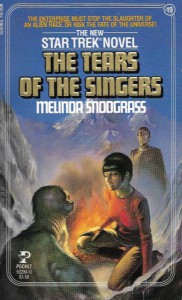Gives Uhura a chance to shine as a character

When a freighter disappears into an expanding time/space warp in the Taygeta V system, Starfleet sends the USS Enterprise to investigate. With them is Guy Maslin, a brilliant but temperamental composer seconded to the mission to help the crew understand the song of the native Taygetans, who may hold a clue to the problem of the warp. When they arrive, however, they encounter a force of two Klingon vessels commanded by James Kirk's old adversary Kor, who has been dispatched on a mission similar to that of the Enterprise. Forging an uneasy agreement, the two groups work together to solve the mystery of the Taygetans before the rift consumes the system's sun — and possibly the galaxy itself.
Years before she became a script editor for Star Trek: The Next Generation and the writer of one of that's show's greatest episodes, Melinda Snodgrass entered the Star Trek franchise with this novel. For a first novel it's a well-developed work, with an interesting plot premised around a strong mystery. In it she makes especially good use of Uhura, one of the underutilized characters from the original series who only got a chance to flourish in the later works of the franchise. At Snodgrass's hands she develops into a strong and capable officer who demonstrates her full value as a ship's crew member. Snodgrass also does justice to the Klingons, who until that point had not always been well served by the novels (that John M. Ford's The Final Reflection was published just four months before Snodgrass's book suggests that hers was among the last Star Trek works not shaped by his influential book). Yet some elements of her story have not aged well; the idea of the Federation authorizing the slaughter of animals for the collectibles they produce doesn't fit well with Roddenberry's vision, while Guy Maslin's behavior seems particularly incongruous in the era of #MeToo. Yet these are relatively minor when set against the strengths of one of the better Star Trek novels form the 1980s Pocket Books era.






